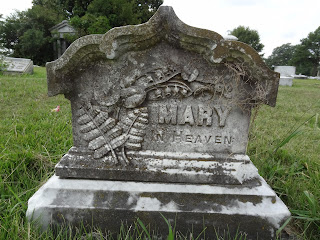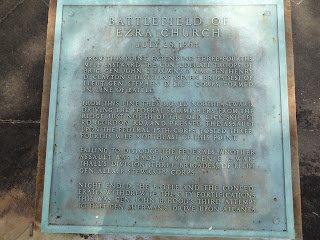In March we took a weekend trip to
Congaree National Park near Columbia, South Carolina. This is one of the newest National Parks, established in 2003. Congaree has one of the highest temperate forest canopies in the world (mostly due to the fact that nearly all temperate forests on Earth were cut down at some point in their history). The forest canopy and old growth forest makes this a unique park, and gives visitors an idea of what much of eastern North America must have looked like before European settlement and clear-cutting.
For this trip, we were joined by our Atlanta friend, Jenny (you may recall her from our
Puerto Rico adventure) and a friend that recently moved from Texas (we visited her in
Dallas last year) to Raleigh, Lindsay. We stayed in Columbia for two nights and took in some of the sights and tastes of this southern capital city.
The first day of the trip we stopped by a small roller coaster in Augusta and toured some of downtown Columbia, before eating at a local brewpub near our hotel. The beer wasn't the best, but the building was really cool and it's good to see beer culture spreading throughout the south.
 |
| On the way we stopped in Augusta for Paul to get a Wacky Worm coaster credit. Jenny rode too! |
 |
| University of South Carolina Campus |
 |
| South Carolina State Capitol grounds |
 |
| Statue of a palmetto in the Capitol grounds |
 |
| South Carolina... you so racist |
 |
| Monument to African American history, from slave ship to post Jim Crow |
On Saturday morning we got up early and went to
Soda City Market, a cute farmer's market on main street. We got breakfast and some snacks to bring to Congaree. David found homemade kimchi too! After the market, we drove down to the national park to meet a guide for our kayak trip. Congaree has lots of water; a large portion of the park is basically a swamp. We kayaked on Cedar Creek for about three hours. The middle of March is a great time to go. There aren't any mosquitoes yet and the weather isn't too hot. There was a big ice storm in February that knocked down a lot of trees, so at times it was like kayaking through a maze trying to avoid downed trees and branches. It made for an exciting trip! When it was time to turn around and head back, we got a bit turned around and we got lost. Fortunately, we found our way back in one piece, with the added bonus of an extra hour of kayaking. We had a fantastic time and highly recommend
Adventure Carolina for your kayak needs. To complete our day in Congaree, we took a 4 mile hike in the park. Part of it was on elevated boardwalks, and part was on dirt trails. It was neat walking past swampy areas and huge loblolly pines. Because of heavy flooding, there were some areas covered in water - but we only got a little bit muddy.
 |
| Downtown Columbia farmer's market |
 |
| Where does this door go!? Narnia I bet! I'll bring kimchi. |
 |
| New style of National Park sign. Fancy! |
 |
| Kayaking crew |
 |
| Beautiful day to be outside |
 |
| No leaves yet, unfortunately, but also no mosquitoes! |
 |
| Congaree is basically a swamp... |
 |
| ...with some massive trees! |
 |
| Paddle! |
 |
| Lots of trees had "knees." Interestingly enough, botanists aren't really sure what they're for. |
 |
| The kayak crew! |
 |
| Avoid the tree! |
 |
| We were some of the only people out in Congaree this day |
 |
| Nature... you crazy! |
 |
| Jenny, we love you, but if you fall in that water you're on your own, girl! |
 |
| Recent flooding (common in the spring) made some of the boardwalks impassable |
After a day full of hiking and kayaking, we went back to Columbia for a showers and a nice dinner. We went to
Motor Supply Co. Bistro for dinner in the Vista neighborhood, a short distance from our hotel. This area of town is home to lots of restaurants and bars and they were all hopping. The city had a big St. Patrick's day party in Five Points and people spilled over into nearby neighborhoods to keep the festivities going. When you see people that drunk at 8PM you know it must be St. Patrick's day!
The following day we had hoped to explore more of Columbia outdoors, but nature had another plan. It rained all day. So instead, we took a little driving tour to see some of Columbia's historic houses and quirky Americana, then went to the South Carolina State Museum. The museum was nice and was a combination natural history and state history museum. They're adding on a large planetarium later this year, so next time we pass through we'll be sure to return.
We parted ways with Lindsay at the State Museum, since she had to drive back to North Carolina. On our way back to Atlanta we stopped in Augusta for dinner and met David's aunt Marianne and cousin Will at
Whiskey Bar/Kitchen. After catching up for a bit we crossed the bridge back into South Carolina to seize a photo-op with an awkward statue!
 |
| World's largest fire hydrant. Check! |
 |
| It would look more real if there weren't a car parked right in front of it |
 |
| Giant prehistoric North American mammals are the best prehistoric mammals! |
 |
| Being such an avid ice cream connoisseur, Paul stopped in for a bite at Paradise Ice |
 |
| On the way home we visited David's cousin and aunt in Augusta for dinner and a jump! |
The area around Columbia is an interesting visit. While the city itself is just OK, the real attraction is Congaree National Park. The huge trees and unique biosphere are really worth visiting. So grab a kayak and get going!

















































































































